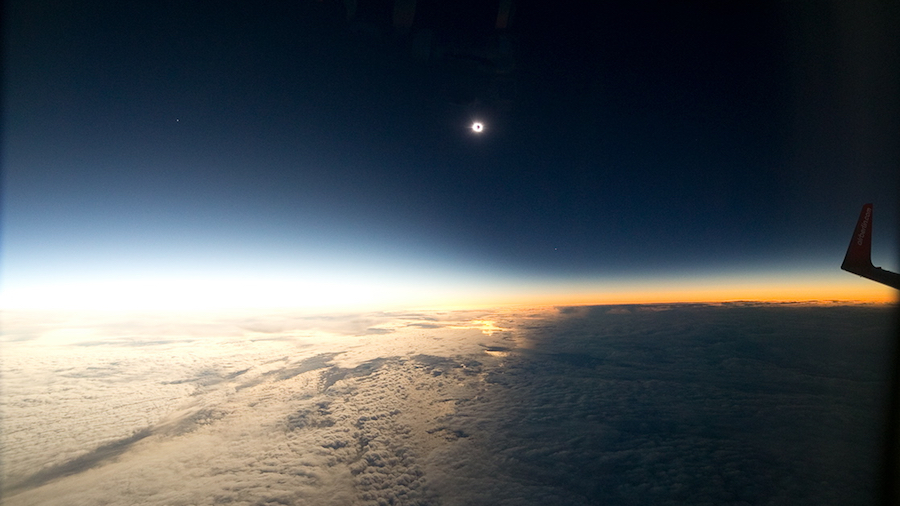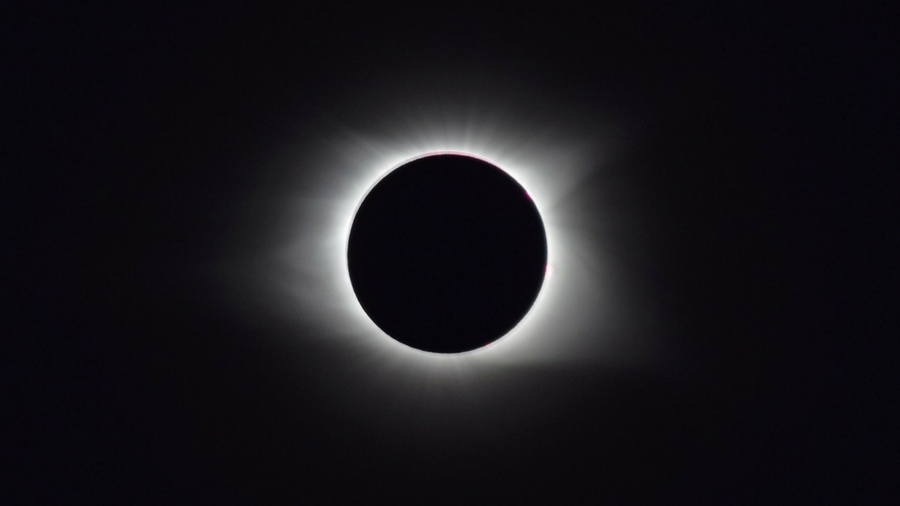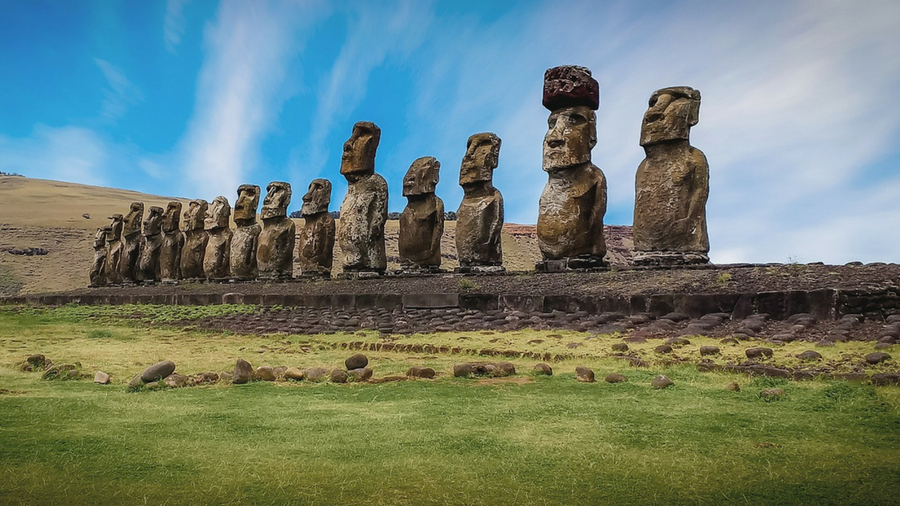The 787 planning to intercept the 'Einstein eclipse'
Set the controls for the path of the Sun

As far as inflight entertainment goes, EFLIGHT 2019-MAX has it sorted. Not only will this Boeing 787-9 Dreamliner gives its passengers a view of a rare total solar eclipse above the clouds, but it will chase this natural phenomenon as it rolls across the planet, extending what would otherwise be a two-minute totality to an eight or even nine-minute totality.
EFLIGHT 2019-MAX is scheduled to take off from Easter Island on July 2 2019, the date of the next total solar eclipse, and race along with the moon's shadow at at over 560mph. Fancy being on board? It'll cost you: seats are priced from $6,750 to $9,750.
- Do you have a brilliant idea for the next great tech innovation? Enter our Tech Innovation for the Future competition and you could win up to £10,000!
What is a total solar eclipse?
Remember the Great American Eclipse? If you were in the US on August 21 2017, you'll know all about eclipses and the wonder of totality. A total solar eclipse is when a new moon crosses the Sun as seen from a particular, and rather narrow, path across the surface of the Earth. That's called the path of totality, and only within this 70 miles (or so) wide zone can you witness the moon shadow sweeping across you.

The temperature drops, daylight fades to night, and all that's left is a beautiful halo around the moon – the Sun's corona. During a precious couple of minutes it becomes obvious that the Sun is not yellow, but ice-white. The structure you can see in the solar corona is incredible; it twists and billows, and within it you can see bright red explosions on the surface of the Sun. As the moon moves away, beads of sunlight pour through the valleys of the Moon, eventually causing a flash of light called the diamond ring. Totality is over. As emotionally powerful as it is visually stunning, totality is so sweet, but so short.
Why is EFLIGHT 2019-MAX intercepting the eclipse?
And that's the trouble with totality – it only lasts a couple of minutes. Only a relatively small part of Chile and Argentina will get a good view of the July 2019 total solar eclipse, and only for about 2 minutes and 20 seconds. Since total solar eclipses only occur every 16 months or so, why not try extending that to nine minutes?

EFLIGHT 2019-MAX is the brainchild of Dr Glenn Schneider of the Steward Observatory and the Department of Astronomy at the University of Arizona, in collaboration with eclipse-chaser John Beattie. "It's an absolutely spectacular experience to watch, from horizon to horizon, the transit of the moon's shadow as it's projected on to the surface of the Earth," says Schneider. And he should know: an avid eclipse-chaser, he’s seen 34 total solar eclipses, including six from the air at altitudes up to 41,000ft.
How is the EFLIGHT 2019-MAX's flightpath calculated?
"It's all about velocity of the moon's shadow, and how much it slows down," explains Schneider. "The moon is relatively close to Earth during this eclipse, so the shadow is wider, it's close to the equator, where the rotational velocity of the air helps, and there's also the high speed of the aircraft."
Get daily insight, inspiration and deals in your inbox
Sign up for breaking news, reviews, opinion, top tech deals, and more.
The geometrical circumstances are ideal for such a chase. "The velocity of the moon's shadow at the point of greatest eclipse – about 4 minutes 32 seconds – is only 2,000kmh [about 1,240mph], so the aircraft speed, which is a little bit less than half of that, will prolong the duration to approximately nine minutes," explains Schneider.

His eclipse flight of 11 July 2010 was the last time a flight with as long a duration of totality as EFLIGHT 2019-MAX was possible, but 2019 will be a one-off. "It is a unique thing we're doing," says Schneider. "It's all about the look-up angle through the airline's windows, and a 787 has very tall windows compared to most aircraft."
Although it can’t be repeated, the supersonic but now-retired Concorde raced the Moon’s shadow along the the Tropic of Cancer back in 1973 to create a whopping 74-minute totality.
Where will everyone sit on EFLIGHT 2019-MAX?
All on one side, although in economy some rows have access to two windows and some to one, such is the configuration of the aircraft. "You buy yourself a row of seats, and if you want to time-share those nine minutes of totality with a partner or friend, then you can do that at no extra cost," says Schneider. "It's a little different in the front of the aircraft, where seating arrangements are different in business class, where you book an individual window."

Since the eclipse will be at an elevation angle of 50 degrees above the horizon, it will be difficult for two people to observe simultaneously in a row with only one window. "I expect the majority will be individual people using an entire row, though maybe a third will be sharing," says Schneider. "With nine minutes of totality, you can trade off."
Why is it called the 'Einstein eclipse'?
The Great South American Eclipse that will occur on July 2 2019 comes a fraction over 100 years since a total solar eclipse on May 29 1919 which proved that Albert Einstein's General Theory of Relativity, first described in 1915, was correct. It changed science forever.
In Einstein's theory, the gravitational field of the Sun should bend light, since it distorts spacetime in its vicinity. The only time, a century ago, it was possible to test that theory was during totality, when it was possible to photograph the position of stars around the Sun, and later see how their exact position differed using photographs of the same stars in a regular night sky.

It's called gravitational lensing, and it's regularly observed today in deep space. On the island of Principe, off the west coast of Africa, British astronomer Arthur Stanley Eddington took photographs that proved Einstein's theory was correct. Physics has never been the same since.
While it's now possible to prove Einstein was right using some fairly basic equipment, such an eclipse experiment is better performed from the ground. However, there will certainly be astronomers on board EFLIGHT 2019-MAX to get the best view of one of nature’s greatest events.
“The sky clarity is great for observing totality, but the view of the shadow and its motion across the Earth is an unbelievable thing to see,” says Schneider. “It really puts you in your place in the solar system.”
TechRadar's Next Up series is brought to you in association with Honor

Jamie is a freelance tech, travel and space journalist based in the UK. He’s been writing regularly for Techradar since it was launched in 2008 and also writes regularly for Forbes, The Telegraph, the South China Morning Post, Sky & Telescope and the Sky At Night magazine as well as other Future titles T3, Digital Camera World, All About Space and Space.com. He also edits two of his own websites, TravGear.com and WhenIsTheNextEclipse.com that reflect his obsession with travel gear and solar eclipse travel. He is the author of A Stargazing Program For Beginners (Springer, 2015),
